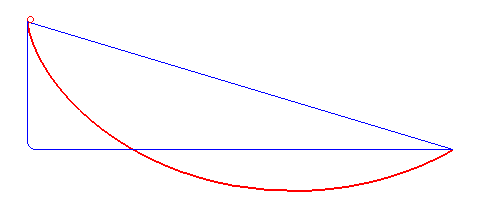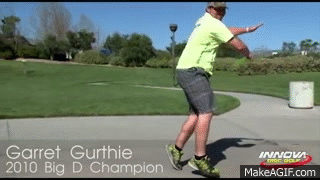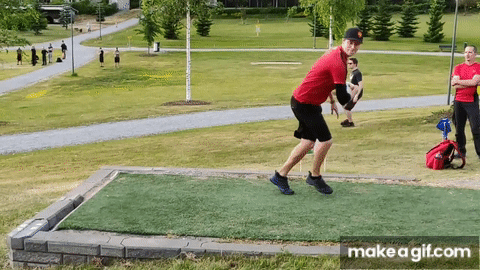Yeah I follow you! Let me see if this helps integrate some of this with the "crescent" idea and linear force you're talking about as drives power up. This is as much for my benefit in thinking about it so apologies if I'm a little verbose, but hopefully it is also inspirational

Think about walking forward- as your hips swivel and sway a bit, your legs are also probably doing slight crescent moves naturally. The problem for the backhand is finding the "best" one for you. It's part the strides, part balance/balance, and part the direct you commit the movement of you CoG overall down the tee.
I think it you watch the people with the more linear appearing plant sweep (not really out in out or maybe closer to out-in like PP or GG) you will still see a transition of their center of mass and gravity in the direction SW pointed out (more Eastward) above to remain athletically balanced in transition.
I'll use GG and my own move as an example because mine is developing more like his and since I think my grasp on how his move works continues to increase as I work on my form. Yours will end up more horizontal, so it will likely rely more on force of that direction but ideally your most efficient form would have a bit of what I'm talking about. At the bottom of it I think the dynamics are similar.
Since I just physically realized the connection between my Waltz box step advanced posture and transition move for the backhand, it changed my frame of reference to realize that the legs are only doing the best they can if (1) you find the right trajectory for your center of gravity in a way that (2) your feet are basically just carrying and accelerating the momentum while (3) not impeding natural actions of the legs (crescent moves that get stretched out as you add momentum).
My move is definitely going to be among the more centrifugal forms I can think of, and similar to Sidewinder's. That's kind of a detail though and IMO more about how our bodies naturally move for quickness and power. I'll try to make the more general example of what I've just learned better since I finally made the connection in my body.
Even though my strides now look pretty "linear toward the target" - and they are as I add momentum - they've still got a little bit of that natural "crescent" action you're describing, slightly out-in-out, and they're moving that way to allow my center to move (1) very targetward like a bowling ball and also (2) like a pendulum bringing in my mass high-low-high-low like waltz or GG and finally (3) making it very centrifugal and rapidly accelerating at the end as I "drop" through the drive step AND into the plant (like waltz or GG).
Seabas Hershyzer drill is generally what you want for that transition from when the x step lands forward. But your own issue is upstream to that and I think that is the case for every person unless they're already throwing like a touring pro. I recommended DD to you - if you do that right, at the peak of the backswing, you should feel your balance in the rear foot and like you will shift "behind" you. That's exactly how part of the waltz box step works, except in DG it's in athletic rather than dance posture. Also notice the similarity in the little backswing I do with a pitcher's windup getting tall and a bit coiled and with my balance moving like Double Dragon: it's setting up the most effortless move forward and "down the mound" like a pitcher but in the backhand direction. This move isn't perfect because I am still trying to get my body to remain in the aggressive balance all the way into my X-step, but contains what I'm talking about:
The other part is that you want to take the stride out of whatever your first move is forward(ish) in a way that sustains and can accelerate momentum rather than jams, blocks, or slows it in any way. That's probably going to be more like an out-in-out or out-in stride, whatever more naturally transitions your whole body mass along the most efficient trajectory. That usually takes trial and error even if you're already doing something else very well.
Also worth mentioning because I became somewhat advanced at waltz that the dance is deceiving: a beginner dancer will take maybe 4-5 times the number of box step rotations to make the same distance over the same amount time as an advanced dancer. An elite waltzer is actually moving deceptively athletically and fast but at low effort directly down the dance line while also rotating faster or slower depending on the move. Is it as explosive as a sprinter? No, but it's nevertheless a powerful move and the best I've got personally. I also know from my waltz training that I can start to make my own move quicker and more aggressively balanced for more power now that I understand it in the context of the backhand.
After I had this Waltz insight by FEELING it, I suddenly realized Simon's transition move is actually pretty similar to one I learned in the Foxtrot (I wish I could remember the pattern name) but was always very hard for me to do/find the posture for it while moving quickly. I think I've only seen people who dance very young and usually for a long time do it as well as he can. But here again we would find your same observation about the "crescent" and stretching it out longer and more linear as you add momentum.
Dickerson and Heimburg run. Eagle and Simon stride. Tartar and Gurthe Waltz. McBeth crow hops. But I think I understand what all of these have in common after mapping it to the move I was most advanced at before I started getting obsessed with form. Mine will now inevitably end up quite a bit more like the Waltz.
You just need to find yours.





